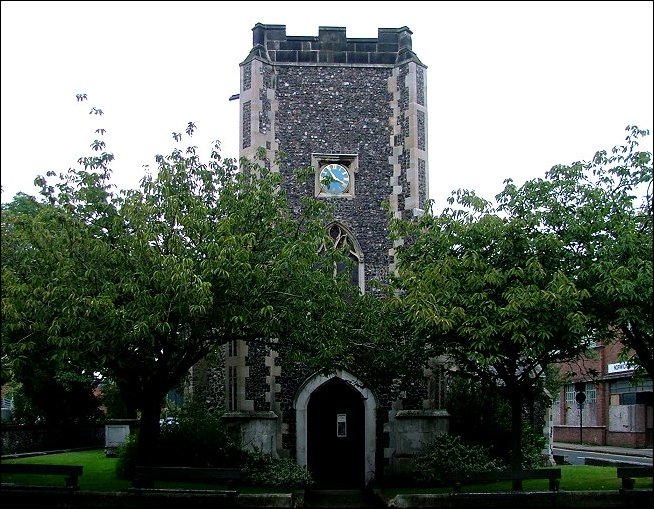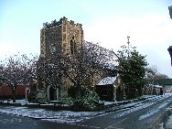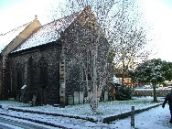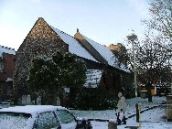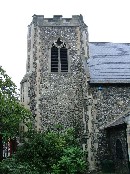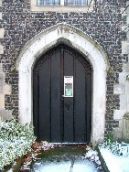| |
|
St
Saviour, Norwich
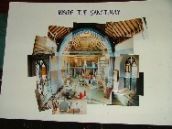 |
|
Of
all the redundant medieval churches in Norwich,
this is the one that I feel most sorry for. Far
from being hemmed in and overshadowed by the
modern city, St Saviour has been completely
exposed by the clearance of buildings around it,
and given some monstrous new neighbours into the
bargain. It sits halfway along Magdalene Street,
but the great flyover of the inner ring road
soars beside it; the graveyard, shown as pretty
in pictures of a century ago, has been completely
cleared for the ignomony of a car park and, if
you please, a large public lavatory has been
built immediately to the east. On the other side
of the bypass is the massive block of Anglia
Square and the hideous tower of Sovereign House,
home of Her Majesty's Stationery Office. |
As if this
wasn't bad enough, St Saviour is such a sweet little
thing, not an urban church at all. It looks for all the
world like a village parish church that has come to the
city and got lost; it now sits shivering, far from home,
while the metropolitan whirl goes on around it. Somewhere
along the way it has lost the top third of its tower, and
the 19th century parapet replacement is small recompense.
But all is not as it seems, as we shall see.
The
medieval dedication of the church was to the
Transfiguration of the Holy Saviour. In Victorian times
this church was host to some fairly muscular low church
worship, and the Rector seems to have been quite a
character. On one occasion, a group of Anglo-catholic
monks settled themselves down here to stare him out at
evensong, only to be chased out of the church and back to
St Laurence by the irate minister.
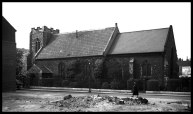 |
|
On
Saturday 26th March 1938, George Plunkett took
photographs of the church, capturing forever St
Swithin on the eve of the Second World War and
the great changes that would overtake this part
of Norwich. They show a typical 19th century low
church interior, a stove pipe rising from the
middle of the nave floor. It is as if time has
stood still for forty years. At the west end is a
gallery with an ornate organ, the font towards
the south door. There is no screen, just
decalogue boards flanking the east window with a
text from scripture in a banner above, a familiar
feature in the low Norwich churches. There are
memorials along the nave walls, with the mayoral
mace and sword rests flanking the Baseley
monument. |
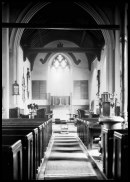 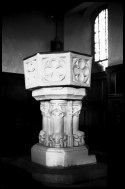 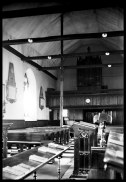
St Saviour
survived the blitz; its near neighbour, St Paul, was
completely destroyed, but this little church soldiered
on, covering St Paul's parish as well as that of the
former parishes of St James and St Edmund, which were by
then both redundant. This was a fairly run down area in
the 1960s - God knows, it is bleak enough now - and once
the flyover had cut St Saviour off from the houses of
north Norwich there was not much chance of a future. The
Brooke Report recommended its closure, and it was
stripped bare, the font going to St George Colegate.
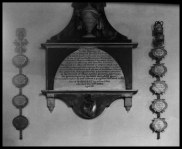 |
|
At
first, St Saviour became a badminton court, and
presumably served a useful purpose for this while
it quietly rotted. And then, as if by a miracle,
salvation came to St Saviour. The King's Church,
Norwich's branch of the New Frontiers
International Church, were offered the lease by
the City authorities. They had
been looking for a central location for their
youth outreach programme; they already had the
lease on St Edmund, but St Saviour is in a much
more prominent and visible location. In the early
1990s they completely renovated this building,
using an architect's plans but doing most of the
work themselves. You can see their photographs of
the work in progress at the start of this
article.
|
The pretty
gallery had been moved to All Saints, but the King's
Church put in a new, larger gallery. This was screened
off beneath to make a cafe/bar area, and the upper storey
forms a meeting area and is the location for the light
and sound equipment. The chancel was also screened off
about half way along, and the easterly part divided into
two storeys, the upper an office and the lower a
backstage area.
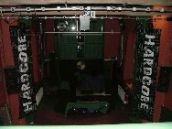  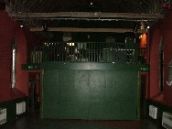 
All of
this is designed so that it can be taken out if ever it
becomes necessary. The plaster ceiling was removed,
revealing an intricate scissor-brace roof. The interior
was painted throughout in green and orange, which is more
effective than it sounds, as I hope you can see in the
images below. The monuments are all still in situ.
Originally
called the Sanctuary by its new owners, St Saviour was
renamed the Gate, and today hosts weekly youth club
sessions called GateCrash, and regular youth worship
called HardCore. There are also opportunities for groups
to take part in discussions, counselling and so on. I
think this is a perfect reuse of an urban medieval
building which might be otherwise left to fall down; a
vital facility for this part of Norwich, and still a
spiritual touchstone.
Simon Knott, December 2005
|
|
|

